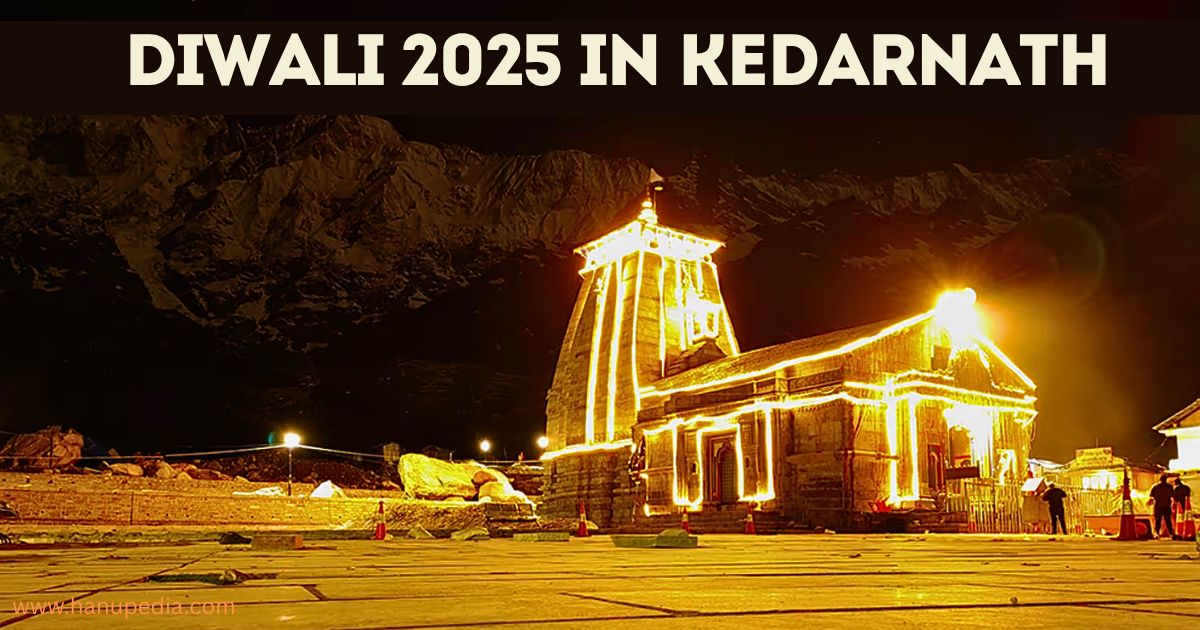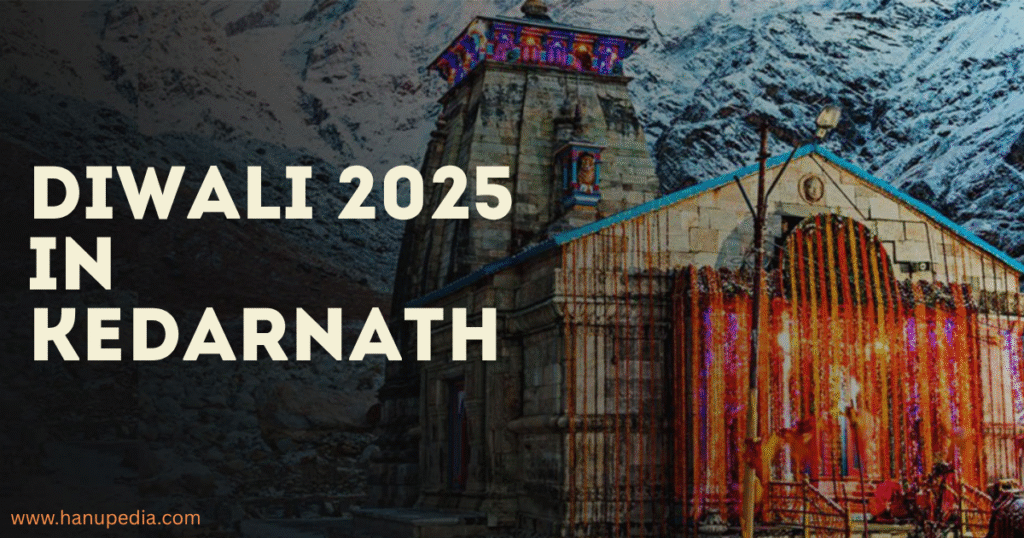Experience Diwali 2025 in Kedarnath: puja timings, travel tips, trekking advice, accommodation, and spiritual highlights for a safe and soulful pilgrimage.
Experience Diwali 2025 in Kedarnath—where the festival of lights meets the raw, snowy grandeur of the Himalayas. This concise guide shows you how to plan a safe, soulful pilgrimage with practical details on travel, puja timings, accommodation, packing, and altitude tips so you can fully savor the temple rituals and mountain atmosphere.
Table of Contents
- Why celebrate Diwali in Kedarnath?
- Quick facts: Diwali 2025 in Kedarnath (snapshot)
- Planning your pilgrimage — timing, permits & safety
- How to reach Kedarnath for Diwali (step-by-step)
- What happens at Kedarnath Temple on Diwali — rituals & atmosphere
- Accommodation, food & local logistics during festival time
- Weather, clothing & altitude precautions
- Photography, dos & don’ts during Diwali puja
- Suggested 3–4 day mini-itinerary around Kedarnath for Diwali pilgrims
- Packing checklist (Diwali in the Himalayas)
- Sustainable & respectful pilgrimage tips
- FAQs (with concise answers)
1. Why celebrate Diwali in Kedarnath?
Diwali — the festival of lights — is a time of renewal, devotion, and family. Celebrating Diwali 2025 in Kedarnath adds a Himalayan dimension: the festival’s lamps glowing against snow-sprinkled peaks, the scent of incense in thin mountain air, and a centuries-old temple that draws pilgrims seeking blessings and spiritual renewal. For many devotees, a Diwali puja at the Kedarnath shrine is profoundly meaningful — a way to connect festival symbolism with the elemental, awe-inspiring Himalayan landscape.
2. Quick facts: Diwali 2025 in Kedarnath (snapshot)
| Topic | Fact / Note |
|---|---|
| Event | Diwali/Deepavali celebrations at Kedarnath Temple |
| Who attends | Devotees, pilgrims, temple priests, seasonal volunteers |
| Temple status | Seasonal: typically open April/May → November. Check official temple announcements before travel. |
| Weather | Cold evenings; possibility of early snow at high altitude |
| Altitude | Kedarnath town ~3,583 m (11,755 ft) — plan for altitude acclimatization |
| Closest motorable point | Gaurikund (approx. 16 km/10 miles trek to Kedarnath) |
| Recommended stay | 2–4 days (puja day + buffer for weather/altitude) |
Note: Temple opening/closing dates, puja timings and special arrangements during festival periods are decided by local authorities and temple management. Always verify official updates before final bookings.

3. Planning your pilgrimage — timing, permits & safety
Temple season & Diwali: Kedarnath temple typically follows a seasonal schedule (open in the warmer months and closed in heavy winter). If Diwali falls within or just after the regular season, special arrangements or extensions are sometimes made; otherwise, devotees may attend nearby temples and memorial sites. Confirm the temple’s official schedule and any announced special Diwali puja.
Permits & registrations: Some gates or parking areas may require entry passes or vehicle permits during high season or special events. Check local administration websites, and if using a travel operator, confirm that they will secure any required passes.
Health & safety: At ~3,583 m, altitude sickness is a real risk. Allow 24–48 hours for basic acclimatization, hydrate, avoid heavy exertion on arrival, and consult your doctor if you have heart or respiratory conditions. Carry basic altitude medication (like acetazolamide) only after physician approval.
4. How to reach Kedarnath for Diwali (step-by-step)
Base cities: Rishikesh, Haridwar, and Dehradun are common starting points. Travel routes may vary depending on road/weather conditions.
-
Fly / train / bus to Dehradun / Haridwar / Rishikesh. These towns offer onward road connections. Haridwar & Rishikesh are popular among pilgrims.
-
Drive to Sonprayag / Gaurikund. Private cars, shared taxis, and buses run on this axis (approx 220–270 km from Rishikesh, depending on route). Road conditions vary — winter-like weather can slow travel.
-
Trek/helicopter to Kedarnath. From Gaurikund, it’s a steady 16 km uphill trek (3–6 hours depending on fitness). Helicopter services (seasonal) land near the temple (landing pads vary); book early as festival demand spikes. Pony/porter services are available, but limit use if possible for ethical reasons.
-
Return: Allow extra buffer days for weather delays or temple timings around Diwali.
Important tip: During festival times, helicopter seats, local transport, and guesthouses fill quickly — book at least 3–4 weeks in advance.
5. What happens at Kedarnath Temple on Diwali — rituals & atmosphere
On Diwali, the temple’s spiritual calendar often includes special aartis, extended temple hours, and extra religious offerings. Typical elements include:
-
Special aarti and lamp lighting: Priests perform aarti with traditional lamps; the scene — lamps flickering against the mountain silhouette — is deeply moving.
-
Offerings: Devotees offer flowers, sweets (prasad), and incense. Many bring traditional homemade offerings to present at the sanctum while following the queue protocols.
-
Chanting & bhajans: Group bhajans and recitations may take place, creating an atmosphere of shared devotion.
-
Community meals/langar: Local organizers sometimes run langars for pilgrims; carry small cash donations when asked.
-
Crowd dynamics: Expect larger pilgrim numbers than on a regular day. Local authorities typically manage queues and safety, but patience is essential.
Respectful behavior is essential: maintain temple decorum, follow priest guidance, and avoid flash photography in the sanctum.
6. Accommodation, food & local logistics during festival time
Where to stay: Kedarnath & vicinity offer basic guesthouses, dharamshalas, and seasonal lodges. High-demand periods like Diwali can push availability; alternatives include staying in Gaurikund, Sonprayag, or Chopta and making day trips.
Food: Local eateries serve simple vegetarian meals — dal, rice, rotis, vegetable curries, and tea. Pack snacks (energy bars, glucose) suitable for high-altitude trekking.
Water & hygiene: Carry purification tablets or a reliable filter bottle. Boiled water is often available, but always confirm.
Connectivity & power: Mobile network coverage is limited. Carry portable power banks; many guesthouses have charging facilities, but expect queues during festivals.
7. Weather, clothing & altitude precautions
Weather snapshot: Even in autumn, mountain evenings are chilly — temperatures can drop below freezing. Early snowfall is possible in late autumn.
Clothing essentials:
-
Layering system: base layer (moisture-wicking), insulating mid-layer (fleece/down), waterproof/windproof outer shell
-
Trekking boots, wool socks, gloves, warm hat, neck gaiter
-
Sunglasses (UV protection) and sunscreen — high-altitude sun is stronger
-
Light microspikes or traction aids if the pathways are icy
Altitude precautions:
-
Ascend slowly where possible; take rest breaks.
-
Hydrate well; avoid alcohol and heavy meals before trekking uphill.
-
If severe symptoms appear (persistent headache, nausea, dizziness), descend immediately and seek medical help.
8. Photography, dos & don’ts during Diwali puja
Do:
-
Capture wide-angle shots of the temple lit with lamps against mountain backdrops.
-
Photograph the communal activities respectfully from a distance.
-
Use a small tripod for low-light shots (without obstructing foot traffic).
Don’t:
-
Use flash inside the sanctum or during prayers — it can disturb worship.
-
Block aisles, queues, or emergency routes for a perfect shot.
-
Photograph people without permission, particularly elders and families in prayer.
9. Suggested 3–4 day mini-itinerary around Kedarnath for Diwali pilgrims
Day 0 (arrival base): Reach Rishikesh/Chopta/Haridwar; short rest and gear check.
Day 1 (approach): Drive to Gaurikund / Sonprayag; overnight; light acclimatization walk.
Day 2 (trek & Diwali puja): Early morning trek to Kedarnath; attend Diwali aarti and temple rituals; night in Kedarnath or descend to Gaurikund depending on weather and temple schedule.
Day 3 (buffer/return): Buffer day for weather delays; gentle descent; return to Rishikesh/Haridwar.
Optional Day 4: Visit Chorabari Tal (Gandhi Sarovar) or Ukhimath (if time and energy permit).
Pro tip: Keep the itinerary flexible. Mountain weather can change suddenly.
10. Packing checklist (Diwali in the Himalayas)
Documents & essentials
-
ID proof (Aadhar / passport) + copies
-
Health insurance & emergency contact list
-
Printed or digital confirmation for helicopter/guesthouse bookings
Clothing
-
Thermal base layers (2)
-
Insulating jacket (down or synthetic)
-
Waterproof shell jacket & pants
-
Trekking pants & quick-dry shirts
-
Gloves, warm hat, buff/scarf
-
Sturdy trekking boots + spare socks
Trekking & safety gear
-
Daypack (20–30L) with rain cover
-
Water bottle / filter + hydration tabs
-
Headlamp with spare batteries
-
First-aid kit + altitude meds (consult doctor)
-
Trekking pole(s), sunglasses, sunscreen
Festival & puja items
-
Small packet of flowers & fruit (check temple rules)
-
Sweets/prasad (store-bought to avoid hygiene issues)
-
Lightweight torch/diya alternatives (if allowed)
-
Small donation envelope / loose cash for local langar/contributions
11. Sustainable & respectful pilgrimage tips
-
Leave no trace: Carry back wrappers and non-biodegradable waste.
-
Use local businesses: Hire local guides, eat at local dhabas, and stay in local guesthouses. This supports the mountain economy.
-
Avoid overuse of ponies/porters: Where possible, prefer your own backpack; respect ethical limits on animal loads.
-
Respect timings and rituals: Follow temple staff guidance and avoid disrupting ceremonies.
-
Donate thoughtfully: Support verified community services (local schools, cleanup groups).
12. Frequently Asked Questions (FAQ)
Q: Is Kedarnath open during Diwali 2025?
A: Temple opening and special puja schedules are decided by the local temple committee and government authorities. Confirm current status via official announcements or your tour operator before traveling.
Q: Can I helicopter to Kedarnath on Diwali?
A: Helicopter services are seasonal and must be booked well in advance, especially for festival days. Slots fill quickly during Diwali; check operator schedules and landing pad availability.
Q: What is the best place to stay during Diwali — Kedarnath or Gaurikund?
A: Staying in Kedarnath offers immediate access to pujas but lodging is basic and cold; Gaurikund or Sonprayag provide warmer, easier-to-book accommodation and easier return logistics.
Q: How to avoid altitude sickness?
A: Ascend gradually, hydrate often, rest, avoid alcohol, and consult a physician for preventive medication if needed. If symptoms worsen, descend immediately.
Q: Is it safe for solo female travelers?
A: Many solo female pilgrims travel safely to Kedarnath; choose reputable guesthouses, avoid isolated routes at night, and consider joining group treks or hiring verified local guides for extra safety.
Closing & Call to Action
Diwali 2025 in Kedarnath is a unique blend of Himalayan grandeur and devotional intensity. With careful planning, respect for local customs, and attention to altitude and weather, your pilgrimage can be both safe and deeply meaningful. If you’d like, I can:
-
Convert this guide into a printable Diwali Kedarnath checklist PDF, or
-
Create a social media post pack (Instagram carousel + Pinterest images) optimized to drive bookings; or
-
Draft a bookable email template for local guesthouses/partners to coordinate Diwali pilgrim stays.
Which would you like next? 🙏



